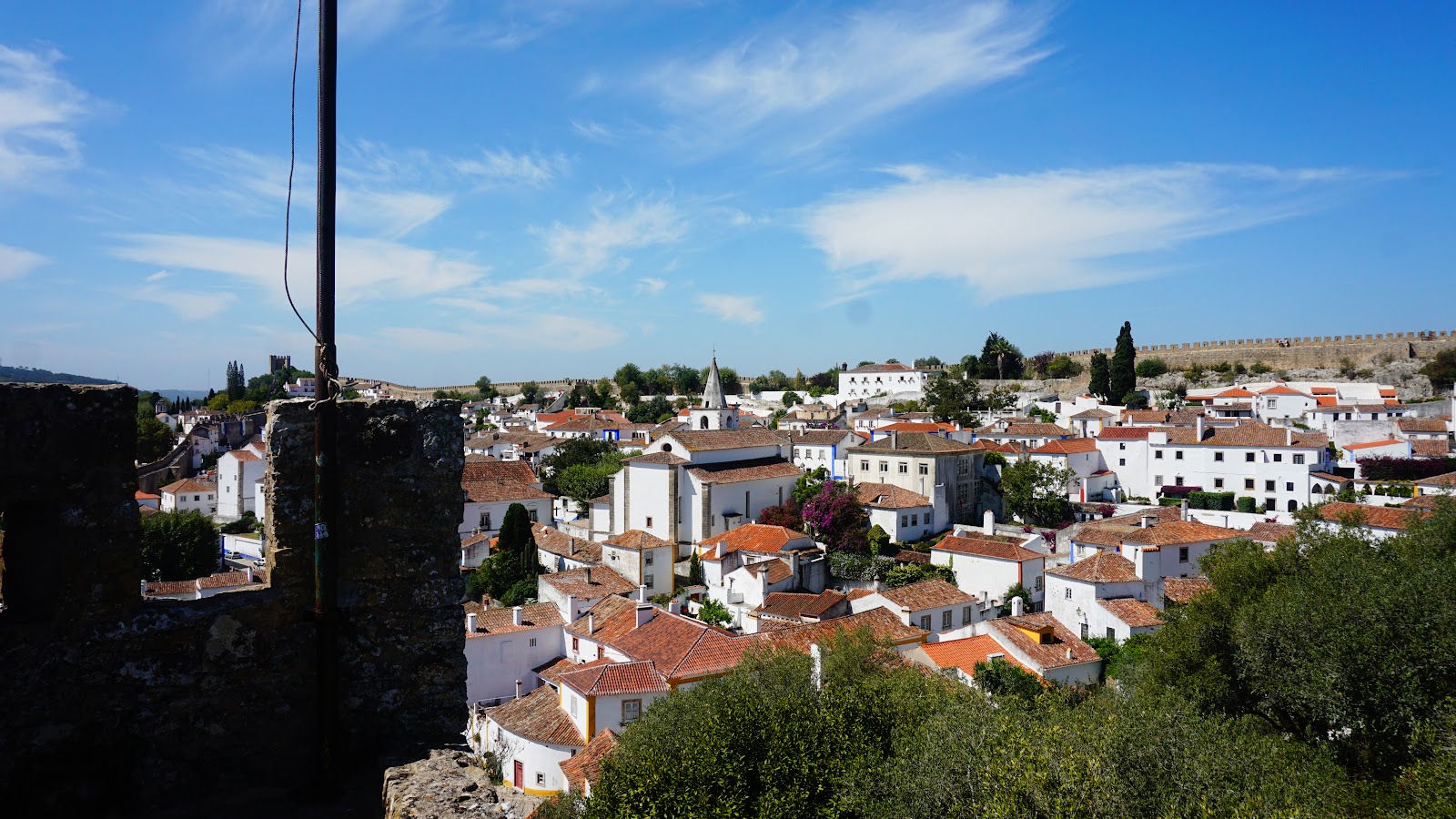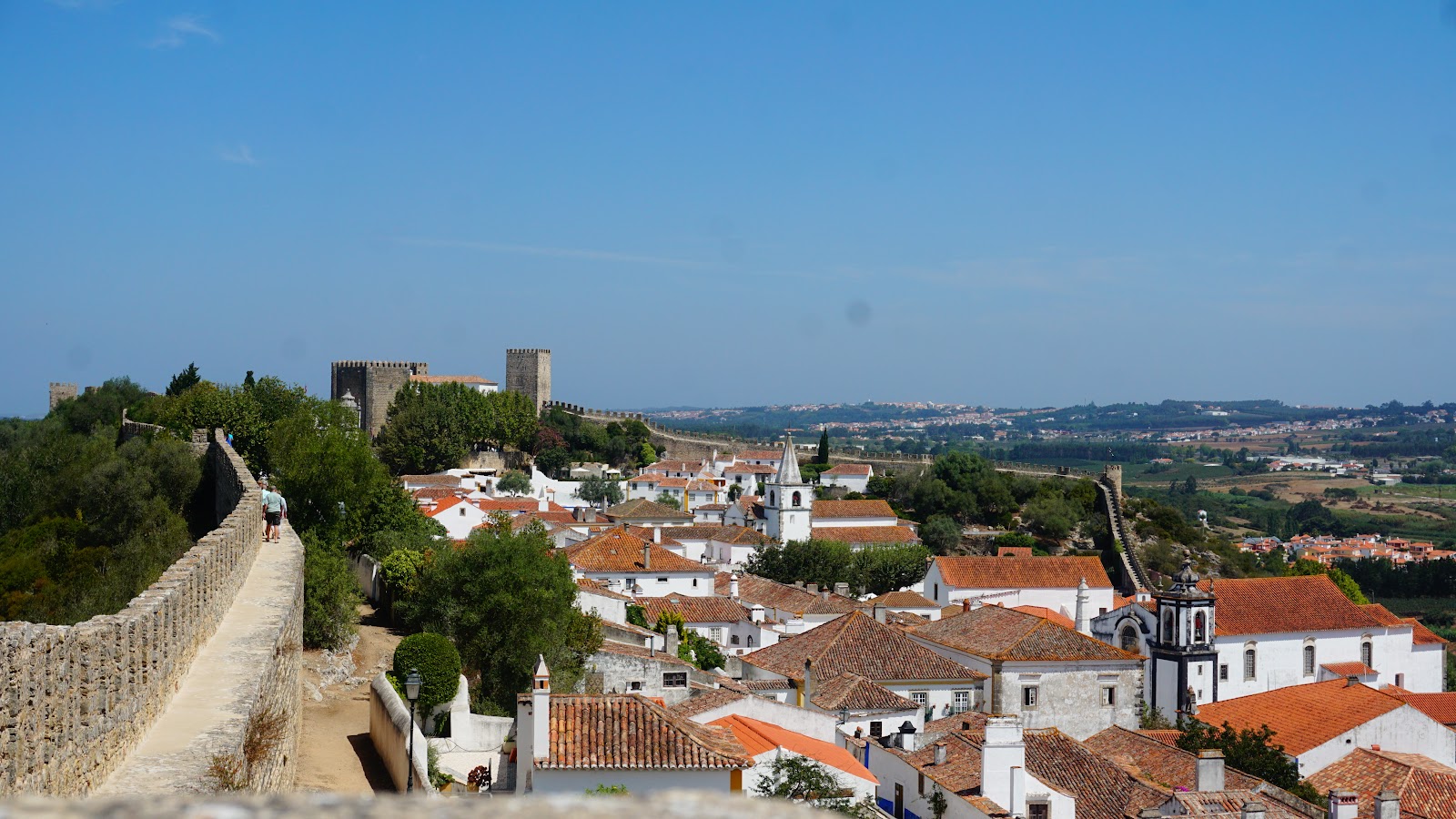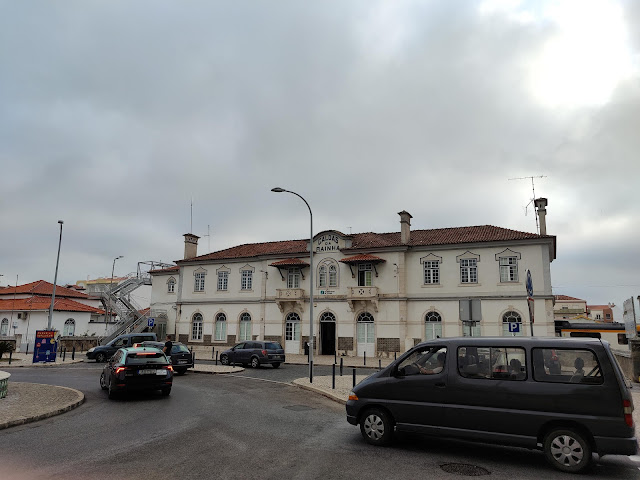A rather hectic day, with a lot of things happening.
 |
| Our place in the morning.
|
Woke up around 9am local time, took about an hour to collect our wits and get ready to head out of the house. Overnight I received an email about our tomorrow's (Aug 24) planned trip to Berlingas Island. Apparently, in addition to tickets for the ferry, we also need permit to come to the islands (these seem to work as the main means of limiting access to the island, which is quite small). The permits are issued by some institute for conservation, they cost 3 Euro per permit, and the only way to pay is some sort of a bank transfer the likes of which I am unable to perform from my US accounts - at least not with on-line tools. So, our day started with a walk to Obidos, not to visit the old town and the castle, but to head to the bank hoping that I can give them those 6 Euro and they can transfer. After waiting for 30 minutes in the bank teller line, we were told that no, this indeed is not possible, we have to do it ourselves. ATM machines were no help either. We then sat down under the walls of the castle and went through all possible ways of doing so - ending up - after about 20 minutes of attempted downloads, over crappy free wi-fi, with using Xoom which apparently is the bank transfer service owned by PayPal. We had to improvise there, but the bank credentials were valid, and eventually Xoom told me that it succeeded in transferring the money.  |
| Obidos, under the walls: spent over an hour here figuring out bank transfer details. |
Around noon we finally made it inside the city walls, and decided that we first will climb the walls and circumnavigate them. We chose to walk counterclockwise - by chance, but the right decision - as the walls have any sort of barrier on the inside only in a few places, and the entire walkway is otherwise not protected at all. It is also quite narrow, and there are a lot of people navigating this path in both directions. Moving counter-clockwise lets one squeeze to the wall when people are passing you (everyone's instincts are to follow the direction of vehicular traffic).
 |
| Obidios city wall, and some of the town itself. |
The historic part of Obidos is not very large. The town hugs a relatively steep hill, and extends for about a kilometer (maybe a bit more if we count the two points on the wall farthest away from each other) in roughly South-North direction, while probably being only 250-300 meters wide for most of this length. Inside are white washed buildings painted blue at the ground level. As the South-North streets are all one above the next, this creates for really picturesque textures, and by far most of my almost 500 photos from the day are of those townscapes.
 |
| Looking south from the eastern wall of Obidos. |
 |
| Some closeups of Obidos houses climbing up the hill. |
On the northern end of the city, at the highest point the the actual castle, which at the moment consists of an enclosed courtyard and walls that house a restaurant and a hotel.
 |
| Obidos Castle, view from the northern tip of the town, where the fairgrounds are located. |
We walked the wall all the way to the castle, dropped back to the street level, visited the insides of the castle, which - again, is just a courtyard with a lot of "Staff only" doors, and then visited a bookstore located in the building of one the many Obidos's churches, where Olga spent some time with a local lace-working master who showed her some of her work (she works on the second floor of the bookshop and has her own small setup here.) Some really nice work.
 |
| Checking the laces. |
 |
| Some of the more intricate lace work. |
We then went to the northernmost part of the town, just past the castle, where there is a field full of empty booths - essentially a small fairgrounds. There we found the way to go up the western wall of Obidos, and we took this wall back to the southern end of town. The western wall is higher up the hill, offers some really nice views out, but also allows for an almost bird's eye view of the town itself. We pathway on along the wall though is quite narrow. I kept on thinking that if this was the US, there'd be wooden rails everywhere or else no walking the walls. I sort of wonder how many people may slip up (the stones paving the pathway should get really slippery when wet). In most places along the wall, you slip and you are done. Only in a few places, where a private garden backs up to the wall, or where for some other reason the street level is soil rather than cobblestone, would one escape with a fracture instead. But I digress. Caution is definitely advised. But the views are fantastic.
 |
| Church of St. Mary in the middle of the town |
 |
| View from the western wall towards the north end of Obidos. |
Eventually we got to the southern tip of the wall, a place where the western wall and the eastern wall connect via a tall tower. At street level there is this one house that spreads from the eastern wall to the western wall, blocking the final pieces of both walls, end essentially enjoying a couple of acres of land on the southern tip of the town all to itself.
 |
| The southernmost house in Obidos - extending from one city wall to the other. |
From the southernmost tip of the walls, one can get a nice view of the next hill over, where our house is situated.
 |
| View from the Obidos city wall towards the house we are staying at. The house itself is not too visible, but the two houses on both sides of it (the round tower-like structures further away in the photo) are visible. |
We climbed the south tower, and took some pictures from there - it is fairly high up, nice views. At the bottom of the tower (city wall path level), there is a hole in the wall, which makes for nice pictures - we took a couple with me as proof that I indeed was there.
 |
| Alex was here. Unfortunately, it was either get your face lit up, or have visible background. |
 |
| Obidos from above (taken from the southernmost tip of the city wall). |
After that, it was a short walk back to where we started the climb. We got to the street level, and went along the main drag to see the souvenir shops and check out the cafes. Our souvenir shopping for the day was minimal, we bought a few postcards and a couple of Obidos prints. We did get some pasteis de nata at a nice little coffeeshop closer to the end of the street, which Olga chased with an espresso, and I - with ginja-infused sangria, which was excellent.
 |
| Our midday snack. |
We then went around the somewhat less travelled lower streets of the town, until we wound up back at the church of St. Mary.
 |
Obidos. Main drag (Rua Direita - very appropriately named), view from above.
|
We went inside for a look, then walked through some side streets a bit more until we came to a small museum which displayed the work of Obidos native, Abilio Leal de Mattos e Silva, who spent most of his time drawing sketches of paintings of Obidos. His work reminds me of the work of an Armenian artist we knew a long time ago whose specialized on panting miniatures of different townscapes in a style quite similar to Sliva's.
 |
| A b/w sketch of Obidos by Abilio Silva. |
 |
| And here is an example of a colored painting of his. |
Afther that after some more side-street walking we went through the restaurant row back to Rua Deireto, where I decide to succumb to the main local ritual - consumption of ginjinha (ginja) - the locally made sour cherry liqueur from a chocolate cup. Took us a bit to find a place (in the afternoon all the stalls along the street get sorta deserted), but I am glad we persisted. Ginja wound up being somewhat different from what I expected. I expected sugar, and it was, indeed, sweet. But I also expected a lot of almond flavor, due to, well cherry pits adding their part. This was very much not the case. The drink was smooth, sweet, but with absolutely no hint of any almond flavors. It reminded me of a homemade alcoholic drink my grandfather would make that he called "drunken cherry", which pretty much was a sour cherry liqueur. Grandfather did it for the cherries themselves - they were used in his dessert-making. Here though, it's the liquid that counts, although most large-ish bottles of ginja I saw have fruit in them.
 |
This is how ginja is made, I guess - the photo is really dark and one cannot see, but about half the volume in each vessel is cherries.
|
.
 |
And this is how ginja is sold on in Obidos (together with some other liquers).
|
Following that, we bought some pasteis de nata-flavored gelato, which we both liked, and went outside the city walls to get some water from a drinking fountain. At that time we decided that we would head home (it was around 3pm, we were starting to get tired), change, and then would go see Caldas da Rainha - a larger town just up the road from Obidos, which presumably is famous for its hot springs, where a queen of Portugal built a hospital.
At home we decided that before heading out to Caldos we would visit local grocery store first, in case we are late coming back. The Continente grocery store is a 2 minute drive from our house - the only challenge was that I needed to turn our SUV around on a tiny parking lot behind the house and drive it down the world's narrowest driveway. Took me a bit (better safe then sorry), but we got down, went to the grocery store, bought some food, and went to Caldos da Rainha.
We spent a total of 2 hours there, just walking the streets at the center of the city, mostly window-shopping (around 6pm the number of open stores started dropping). Unlike Obidos, which is very touristy, Caldos da Rainha is pretty much a solid provincial town in Portugal with close to zero observed tourists (although we heard non-Portuguese languages around, and even some Russian, almost everyone appeared to actually have been a local). While we enjoyed our walk around non-touristy parts of Portugal, one thing we totally failed was to find a restaurant where we could have a dinner. There were some cafes open and a couple of Asian food takeouts, as well as a few burger joints, but we were looking for something with more local food selection, and quite literally, there were no restaurants on most of the streets we walked (and, looking at the map, we covered a decent chunk of the city center, from the train station to the park and to (almost) the hospital, with what remains there from the original hot springs - unfortunately, we did not make quite all the way there to see them.
 |
| Caldos da Rainha train station. Somewhat subdued. |
 |
| Caldos da Rainha. What looks like main city square. |
At around 7:30pm we decided to cut our losses, went back to the parking lot, got into the car and drove the the local Lidl to get some easy-to-prep food. Came home around 8:40pm, made our dinner, and ate it on the ground floor porch - a smaller table, but no need to go up the staircase with a tray of food.
 |
| Our dinner, featuring a microwavable Portuguese bean stew, some seafood croquettes, sausage, cheese, olives, bread and canned octopus. |
After dinner, we called it day.
Alcohol.
1. Portuguese Bock Beer. Per Olga, when people ask about Portuguese beer, this is the one the internets recommend. It is pretty straightforward light beer - for American beer drinkers, reminiscent of the infamous Pabst Blue Ribbon (a slightly more upscale version of it), and for ex-USSR ones - the infamous Zhiguli. Easy to drink, but not the kinds of beers I like.
2. Lagosta Vinho Verde DOC.
 |
| Lagosta Vinho Verde DOC |
A rather budget buy, this is
again surprisingly a wine on the sweeter side with some fizz added to the mix. These wines are typically called "easy drinking summer wines". Olga liked it too.
Steps. Eneded the day with around 21090 steps. Most were in Obidos, but Caldos da Rainha added about 7K steps as well I think.
Tomorrow. Well, the plan is to spend the day at the Berlingas Island - they have some interesting places to go see there. We'll see if we have done enough to actually be able to make it there. If not, I guess we'll walk around Peniche, drive around the Peniche peninsular, and possibly, will hit the beach. We'll try not to get too upset.


























No comments:
Post a Comment